Unit 4 Stories and Poems 单元知识点课件(共91张PPT)
文档属性
| 名称 | Unit 4 Stories and Poems 单元知识点课件(共91张PPT) |  | |
| 格式 | pptx | ||
| 文件大小 | 839.1KB | ||
| 资源类型 | 教案 | ||
| 版本资源 | 冀教版 | ||
| 科目 | 英语 | ||
| 更新时间 | 2024-07-03 22:40:52 | ||
图片预览

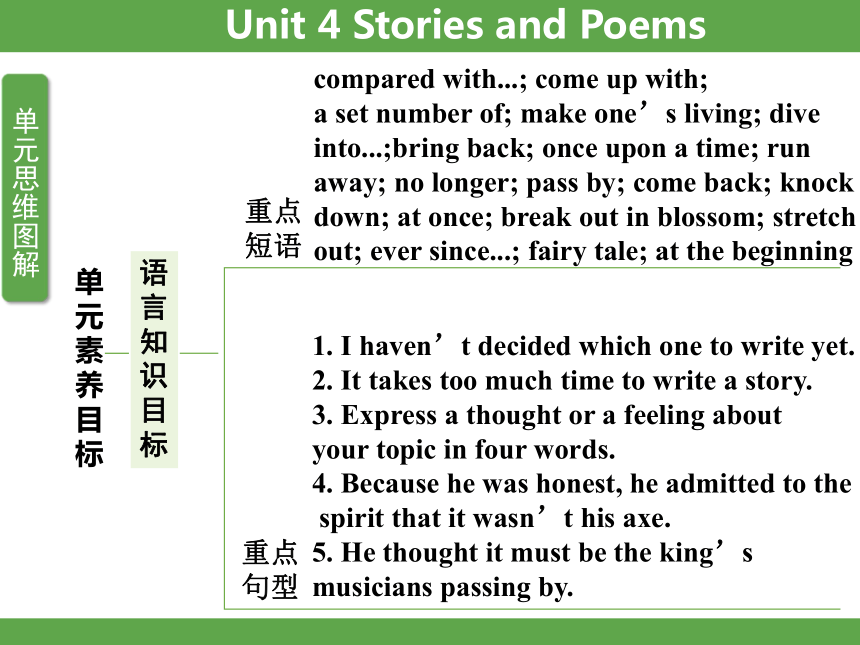

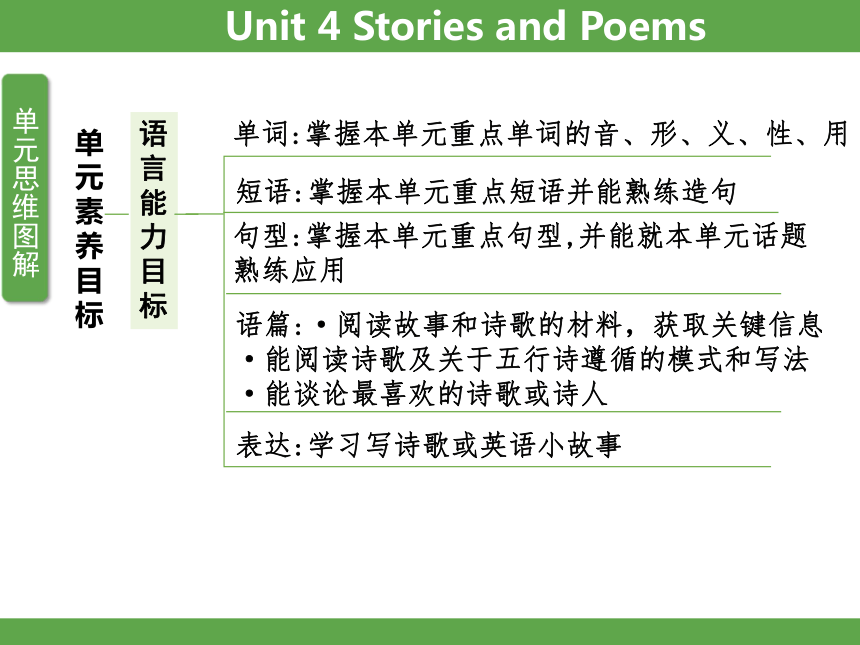
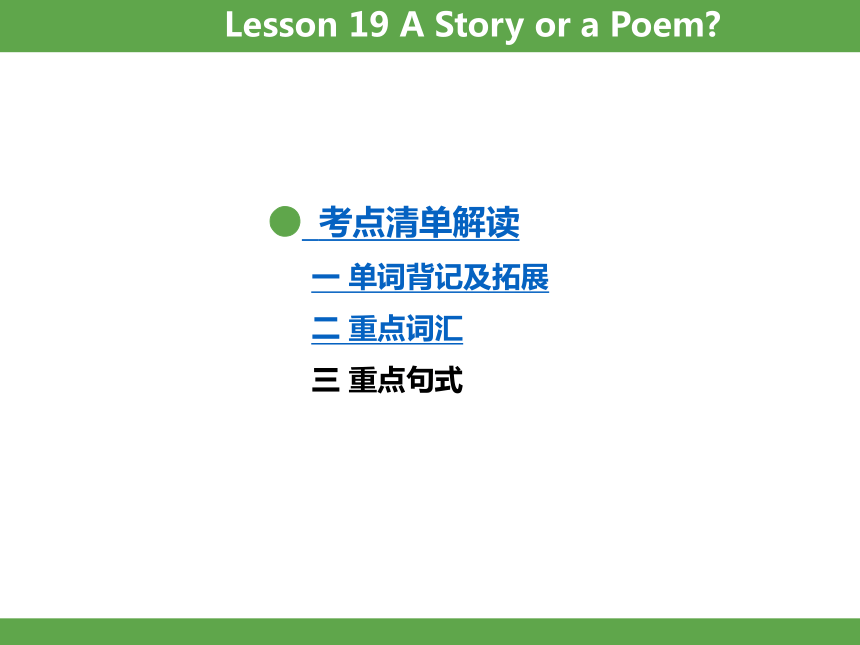
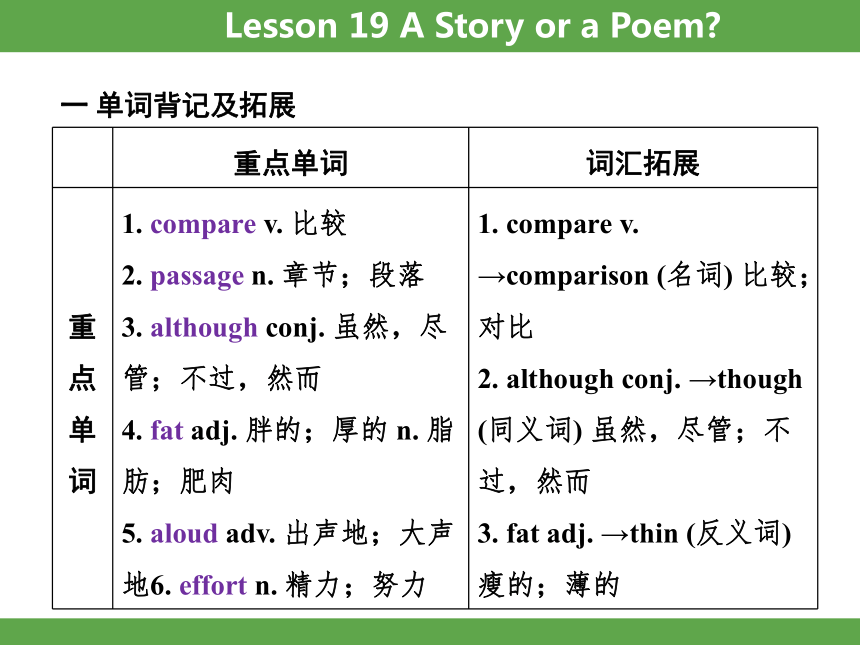
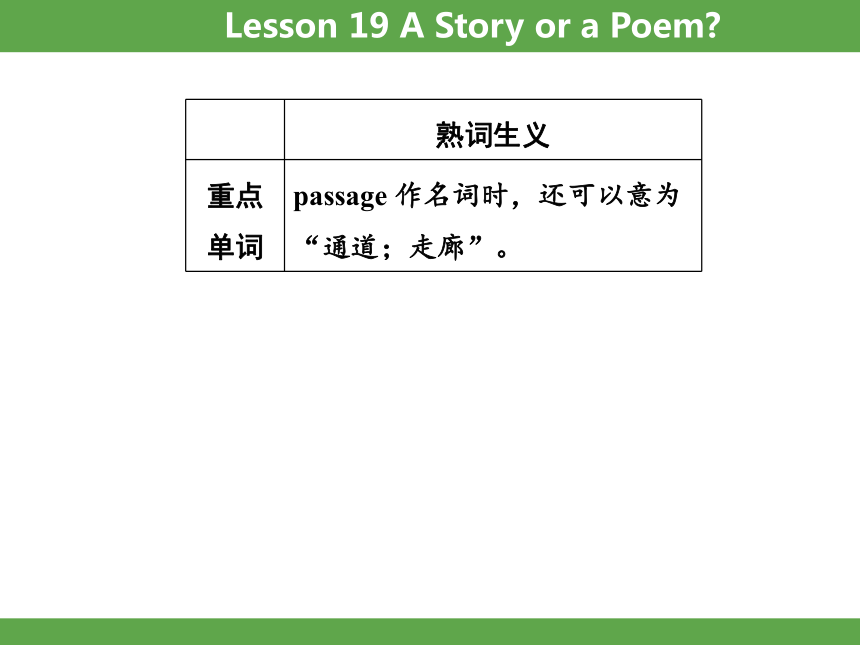
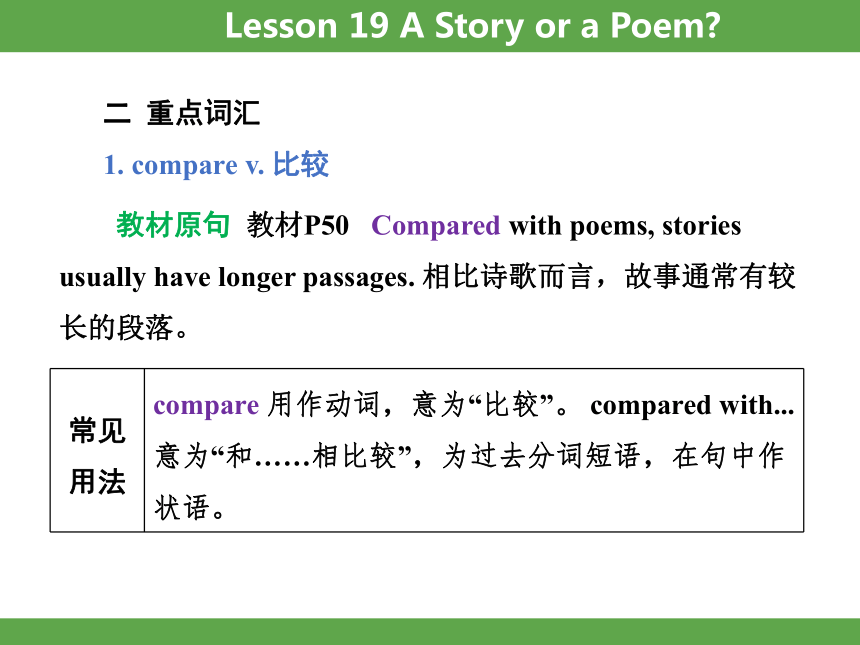
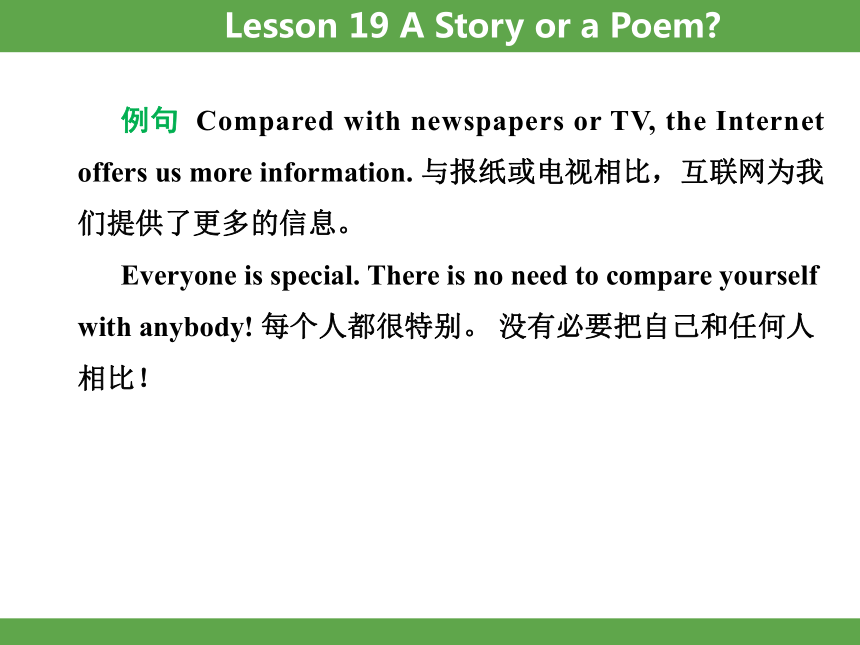

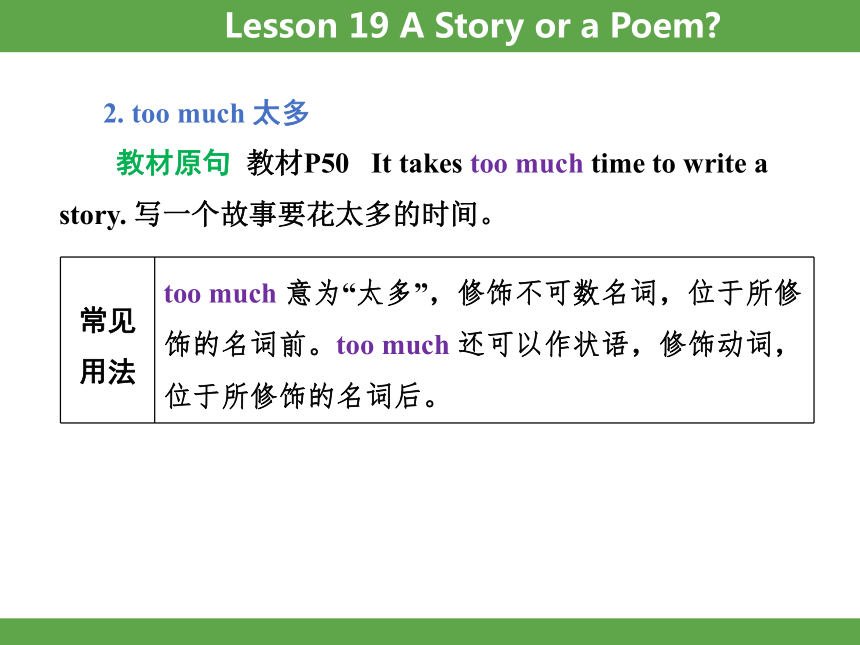
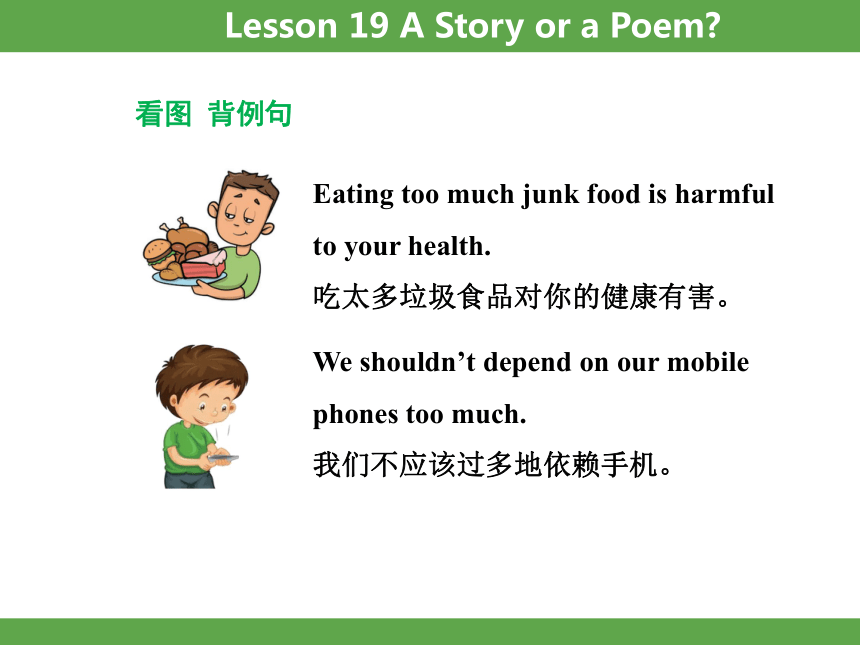
文档简介
(共91张PPT)
语
言
知识目
标
单元素养目标
词汇
话题
Stories and Poems(故事和诗歌)
四会词
compare; passage; although; fat; aloud; line; text; poet; single; screen; state;express; silver; loud; board; awake; musician; perhaps; knock; spread; neck;character; humorous
Unit 4 Stories and Poems
非四
会词
limit; format; rhyme; effort; hum; stretch; liquid; noun; adjective; fable;woodcutter; axe; dive; admit; policy; frightened; peek; softly; scene;crawl; selfish; wicked; fairy; tale; plot
语
言
知识目
标
单元素养目标
Unit 4 Stories and Poems
重点
短语
compared with...; come up with;
a set number of; make one’s living; dive
into...;bring back; once upon a time; run
away; no longer; pass by; come back; knock
down; at once; break out in blossom; stretch
out; ever since...; fairy tale; at the beginning
重点
句型
1. I haven’t decided which one to write yet.
2. It takes too much time to write a story.
3. Express a thought or a feeling about
your topic in four words.
4. Because he was honest, he admitted to the
spirit that it wasn’t his axe.
5. He thought it must be the king’s
musicians passing by.
语
言
知识目
标
单元素养目标
6. He was trying to reach up to the spreading branches of a tree.
7. At the beginning, I was afraid to try writing a poem.
8. Later I decided to write a poem about a cat!
重点
句型
Unit 4 Stories and Poems
语法
过去进行时;情态动词 must 的用法
Unit 4 Stories and Poems
语言能力目标
单元素养目标
单词:掌握本单元重点单词的音、形、义、性、用
短语:掌握本单元重点短语并能熟练造句
句型:掌握本单元重点句型,并能就本单元话题
熟练应用
语篇:·阅读故事和诗歌的材料,获取关键信息
·能阅读诗歌及关于五行诗遵循的模式和写法
·能谈论最喜欢的诗歌或诗人
表达:学习写诗歌或英语小故事
● 考点清单解读
一 单词背记及拓展
二 重点词汇
三 重点句式
Lesson 19 A Story or a Poem
一 单词背记及拓展
重点单词 词汇拓展
重 点 单 词 1. compare v. 比较 2. passage n. 章节;段落 3. although conj. 虽然,尽管;不过,然而 4. fat adj. 胖的;厚的 n. 脂肪;肥肉 5. aloud adv. 出声地;大声地6. effort n. 精力;努力 1. compare v. →comparison (名词) 比较;对比
2. although conj. →though (同义词) 虽然,尽管;不过,然而
3. fat adj. →thin (反义词) 瘦的;薄的
Lesson 19 A Story or a Poem
熟词生义
重点 单词 passage 作名词时,还可以意为
“通道;走廊”。
Lesson 19 A Story or a Poem
二 重点词汇
1. compare v. 比较
教材原句 教材P50 Compared with poems, stories usually have longer passages. 相比诗歌而言,故事通常有较长的段落。
常见用法 compare 用作动词,意为“比较”。 compared with...意为“和……相比较”,为过去分词短语,在句中作状语。
Lesson 19 A Story or a Poem
例句 Compared with newspapers or TV, the Internet offers us more information. 与报纸或电视相比,互联网为我们提供了更多的信息。
Everyone is special. There is no need to compare yourself with anybody! 每个人都很特别。 没有必要把自己和任何人相比!
Lesson 19 A Story or a Poem
易混辨析
compare... with...与 compare... to...
(1)compare A with B 意 为“把 A 和 B 作比较”。
(2)compare A to B 意 为“把A 比作 B”。
Lesson 19 A Story or a Poem
2. too much 太多
教材原句 教材P50 It takes too much time to write a story. 写一个故事要花太多的时间。
常见用法 too much 意为“太多”,修饰不可数名词,位于所修饰的名词前。too much 还可以作状语,修饰动词,位于所修饰的名词后。
Lesson 19 A Story or a Poem
看图 背例句
Lesson 19 A Story or a Poem
Eating too much junk food is harmful to your health.
吃太多垃圾食品对你的健康有害。
We shouldn’t depend on our mobile phones too much.
我们不应该过多地依赖手机。
拓展提升
(1)much too 意为“太”,为副词短语,后跟形容词或副词原级。
(2)too many 意为“太多”,后跟可数名词复数。
Lesson 19 A Story or a Poem
小助记
too much, much too 与 too many 的用法
too much, much too,用法区别看后头。 much 后接不可 数 ,too 后则接形或副。 too many要牢记,其后名词必复数。
三 重点句式
although 引导的让步状语从句
教材原句 教材P50 Although a poem has fewer words, it’s not always easier to write. 虽然诗字数更少,但是写诗并非总是更容易的。
常见用法 although 为连词,意为“尽管,虽然;不过,然而”,与 though 同义,引导让步状语从句。 although 引导的从句放在主句前后均可。
Lesson 19 A Story or a Poem
例句 Although it was snowing, we still went there.
=We still went there although it was snowing.
尽管下着雪,但我们还是去了那儿。
Lesson 19 A Story or a Poem
易错提示
在英语中, 当表示“虽然……,但 是 …… ” 时 ,although / though 不能与 but 在同一个句子中使用。 如:
Although/ Though the Internet is of great use, we shouldn’t be lost in it. = The Internet is of great use, but we shouldn’t be lost in it .
尽管网络有很大的用途,但我们不应该沉迷于网络。
Lesson 19 A Story or a Poem
● 考点清单解读
一 单词背记及拓展
二 重点词汇
三 重点句式
Lesson 20 Say It in Five
一 单词背记及拓展
重点单词 词汇拓展
重 点 单 词 1. line n.(诗)行;路线 2. text n. 正文;文字材料 3. poet n. 诗人 4. single adj. 单一的;单独的 5. screen n. 屏幕;荧光屏 6. stretch v. 伸展 1. poet n. →poem (名词) 诗
2. state v. →stated (过去式/过去分词) 陈述;说明
→stating (现在分词) 陈述;说明
→statement (名词) 陈述;声明
Lesson 20 Say It in Five
一 单词背记及拓展
重点单词 词汇拓展
重 点 单 词 7. liquid adj. 清澈的;晶莹的n. 液体 8. state v. 陈述;说明 9. express v. 表达 3. express v. →expressed (过去式/过去分词) 表达
→expresses (第三人称单数) 表达
→expressing (现在分词) 表达
→expression (名词) 表情;表示;表达
Lesson 20 Say It in Five
熟词生义
重点 单词 state 作动词时,还可以意为“指定;规定”;作名词时,意为“州;国家”。
Lesson 20 Say It in Five
二 重点词汇
1. single adj. 单一的;单独的
教材原句 教材P52 This kind of poem always talks about a single topic. 这种诗歌总是谈论一个单一的主题。
常见用法 (1)single 作形容词,意为“单一的;单独的”,常在句中作定语,没有比较级和最高级形式。
(2)a/ one single+单数名词=only one+单数名词。
Lesson 20 Say It in Five
例句 A journey of a thousand li begins with a single step. 千里之行始于足下。
There is a single table in the room. = There is only one table in the room. 房间里只有一张桌子。
Lesson 20 Say It in Five
拓展提升
single 的其他常见含义:
(1)单程的。 如:a single ticket 单程票
(2)单人的(仅用在名词前)。如:a single room 单人间
(3)单身的,未婚的。 如:Are you married or single 你已婚还是单身?
Lesson 20 Say It in Five
2. a set number of 一定数量的
教材原句 教材P52 Each line has a set number of words. 每一行都有一定数量的单词。
常见用法 a set number of 意为“一定数量的”,相当于 a certain number of。 其后接可数名词复数,该短语作主语时,谓语动词用复数形式。
Lesson 20 Say It in Five
例句 The number of the students in my class is 50, and a set number of them like writing poems. Yesterday a large number of them took part in the sports meeting. 我的班级有 50 名学生,有一定数量的人喜欢写诗。 昨天有许多学生参加了运动会。
Lesson 20 Say It in Five
易混辨析
Lesson 20 Say It in Five
a number of 与the number of
(1)a number of 意为“许多”,后接可数名词的复数形式,可用large, small 等修饰 number。 作主语时,谓语动词用复数形式。
(2)the number of 意 为“……的数量”,后接可数名词的复数形式。 作主语时,谓语动词用单数形式。
3. express v. 表达
教材原句 教材P52 Express a thought or a feeling about your topic in four words. 用四个单词表达关于你的主题的思想或情感。
常见用法 express 作动词,意为“表达”,其后可接名词或 wh-从句。 常用搭配:express sth. to sb. 向某人表达某事/物;express oneself 表达自己的想法。
Lesson 20 Say It in Five
例句 He expressed his views to everyone at the meeting. 会上他向每个人表达了他的观点。
拓展提升
Lesson 20 Say It in Five
expression 是名词,意为“表情;表示;表达”,常 用 搭 配 beyond expression意为“无法形容”。 如:
The scenery was beautiful beyond expression. 那风景漂亮
得无法形容。
三 重点句式
“又……,再……”的英语表达法
教材原句 教材P52 Let’s look at another two poems as examples.让我们看另外两首诗作为例子。
常见用法 (1)another 后跟单数名词或代词,表示“另一个……”。
(2)“another+基数词(大于 1)+复数名词”相当于“基数词(大于 1)+more+复数名词”。
Lesson 20 Say It in Five
例句 I don’t understand what you said. Would you please give me another example 我不明白你在说什么。 你能再举一个例子吗?
They need another three people. = They need three more people. 他们还需要三个人。
Lesson 20 Say It in Five
拓展提升
another 作代词,意为“另一个”,泛指同类事物中三者或三者以上中的“另一个”。 如:
Some animals move from one place to another at certain
times of the year. 一些动物在一年中的特定时间从一个地
方迁徙到另一个地方。
Lesson 20 Say It in Five
● 考点清单解读
一 单词背记及拓展
二 重点词汇
三 重点句式
Lesson 21 The Fable of the Woodcutter
一 单词背记及拓展
重点单词 词汇拓展
重 点 单 词 1. fable n. 寓言 2. axe n. 斧子 3. dive v. 跳水;俯冲 4. admit v. 承认;赞同 5. silver adj. & n. 银(的) 6. policy n. 原则;政策 1. axe n. →axes (复数) 斧子
2. dive v. →dived/ dove (过去式) 跳水;俯冲
→dived (过去分词) 跳水;俯冲
3. admit v. →admitted (过去式/过去分词) 承认;赞同
Lesson 21 The Fable of the Woodcutter
熟词生义
重点单词 silver 作名词时,还可以意为“银币;银器”。
Lesson 21 The Fable of the Woodcutter
二 重点词汇
1. dive v. 跳水;俯冲
教材原句 教材P54 The spirit dove into the lake and brought back a gold axe. 精灵跳入湖中,带回一把金斧头。
常见用法 dive 意为“跳水;俯冲”,过去式为 dived 或 dove。 常用搭配:diveinto 跳入……中,潜入。
Lesson 21 The Fable of the Woodcutter
例句 The man dove into the water and saved that boy. 那个男人跳进水里救了那个男孩。
图解妙记
Lesson 21 The Fable of the Woodcutter
2. admit v. 承认;赞同
教材原句 教材P54 Because he was honest, he admitted to the spirit that it wasn’t his axe. 因为他很诚实,所以他向精灵承认那不是他的斧子。
常见用法 admit 为动词,意为“承认;赞同”,常见用法为:admit sth. 承认/供认某事;admit doing sth. 承认做过某事;admit to sb. that... 向某人承认……,that 引导宾语从句。
Lesson 21 The Fable of the Woodcutter
例句 We should admit our mistakes bravely instead of making excuses. 我们应该勇敢地承认我们的错误而不是找借口。
He admitted having junk food for supper. 他承认晚餐吃了垃圾食品。
Lesson 21 The Fable of the Woodcutter
拓展提升
admit 作动词时,还可意为“准许……进入(某处)”。 如:You will not be admitted to the theatre after the performance has started. 演出开始后不许进入剧场。
Lesson 21 The Fable of the Woodcutter
三 重点句式
1. make one’s living 的用法
教材原句 教材P54 He had only one axe, and he needed it to make his living. 他只有一把斧子,他需要它来谋生。
Lesson 21 The Fable of the Woodcutter
常见用法 make one’s living 相当于 make a living,表示“谋生”,指通过某种工作或技能、手段等来维持生存、度日或生活。 one’s 要与其主语保持一致。
例句 He drives a taxi to make a/ his living. 他靠开出租车谋生。
拓展提升
make a / one ’ sliving by doing sth.意为“通过做某事谋生”。 如:Local fishermen make a living by fishing in the lake. 当地渔民靠在湖里钓鱼谋生。
Lesson 21 The Fable of the Woodcutter
2. 现在分词(短语)作伴随状语
教材原句 教材P54 The man looked at the gold axe, knowing it wasn’t his. 男人看了看金斧头,知道这不是他的。
常见用法 现在分词(短语)作状语时,其逻辑主语就是句子的主语,并且与其为主动关系。现在分词(短语)作状语时,与谓语动词所表示的动作或状态同时发生。
例句 They came into the classroom, talking and laughing. 他们有说有笑地走进教室。
Lesson 21 The Fable of the Woodcutter
易错提示
过去分词(短语)作状语时,所表示的动作是句子主语承受的动作,它们之间的关系是被动关系。 如:
Given another chance, he will do better. 再给他 一 次 机会 , 他会做得更好。
Lesson 21 The Fable of the Woodcutter
3.“a/ an+序数词”的用法
教材原句 教材P54 The spirit went down a third time and returned with the woodcutter’s old axe. 精灵又一次潜下去,并带着樵夫的旧斧子回来了。
常见用法 “a/ an+序数词”意为“又一……”,表示在前面数字的基础上再次出现,不强调顺序性。
例句 We’ve failed three times in the experiment, so we’ll have to try it a fourth time. 我们已经在实验中失败了三次,所以我们不得不再次尝试。
Lesson 21 The Fable of the Woodcutter
拓展提升
“the + 序 数 词 +名词”表示按顺序排列的“第……”。 如:His parents have three children,and the third one is a girl. 他的父母有三个孩子,第三个是一个女孩。
Lesson 21 The Fable of the Woodcutter
● 考点清单解读
一 单词背记及拓展
二 重点词汇
三 重点句式
Lesson 22 The Giant (Ⅰ)
一 单词背记及拓展
重点单词 词汇拓展
重 点 单 词 1. loud adj. 大声的;喧哗的 2. frightened adj. 惊吓的;受惊的;害怕的 3. board n. 板;木板 4. awake adj. 醒着的 5. musician n. 音乐家;乐师 1. loud adj. →loudly (副词) 大声地;喧哗地
→louder (比较级) 更大声的
2. frightened adj. → frightening (形容词)令人恐惧的;令人害怕的
→frighten (动词) 使惊吓;使惊恐
Lesson 22 The Giant (Ⅰ)
重点单词 词汇拓展
重 点 单 词 6. perhaps adv. 也许;可能 3. awake adj. →wake (动词) 醒来;叫醒
→asleep (反义词) 睡着的
4. musician n. →music (名词) 音乐
熟词生义
board 作名词时,还可以意为“布告牌;委员会”。
Lesson 22 The Giant (Ⅰ)
二 重点词汇
loud adj. 大声的;喧哗的
教材原句 教材P56 “What are you doing here ” the giant cried in a loud voice. 巨人大声叫喊:“你们在这里干什么? ”
常见用法 (1)loud 作形容词时,意为“大声的;喧哗的”,在句中可作定语或表语。
(2)loud 作副词时,意为“响亮地;大声地”,主要指说话声和笑声,常用其比较级形式。 常与 speak, shout, laugh, talk 等连用。
Lesson 22 The Giant (Ⅰ)
例句 That music is too loud — please turn it down. 那音乐太响了,请把音量调低一点儿。
Could you speak in a loud voice so that I can hear you clearly 你能大声点说话吗,以便我能听清楚?
Don’t talk so loud. 不要如此高声地谈话。
Lesson 22 The Giant (Ⅰ)
拓展提升
其他表示“大声”的副词
Lesson 22 The Giant (Ⅰ)
单词及含义 用法
aloud出声地; 大声地 有“使 听 得 到 ”的 意味,与 cry,call, shout, read等连用。
loudly大声地; 吵闹地 含“喧 闹” 的意味,通常有令人讨厌或打扰别人之意。
三 重点句式
no longer 的用法
教材原句 教材P56 The poor children no longer had a place to play. 可怜的孩子们不再有地方玩耍了。
常见用法 no longer 意为“不再”,通常放在行为动词前,be 动词后,多与延续性动词连用,着重表示时间或动作不再延续,相当于not... any longer。
例句 You are no longer young. = You are not young any longer. 你不再年轻了。
Lesson 22 The Giant (Ⅰ)
易错提示
no more 表示“不再”,着重表示程度上或做某事的次数不再增加,多与瞬间动词连用 , 相当于 not . . . any
more。 如:
We saw him no more. = We didn’t see him any more.
我们再也没有看到他。
Lesson 22 The Giant (Ⅰ)
2. 现在分词(短语)作伴随状语
教材原句 教材P54 The man looked at the gold axe, knowing it wasn’t his. 男人看了看金斧头,知道这不是他的。
常见用法 现在分词(短语)作状语时,其逻辑主语就是句子的主语,并且与其为主动关系。现在分词(短语)作状语时,与谓语动词所表示的动作或状态同时发生。
例句 They came into the classroom, talking and laughing. 他们有说有笑地走进教室。
Lesson 22 The Giant (Ⅰ)
易错提示
过去分词(短语)作状语时,所表示的动作是句子主语承受的动作,它们之间的关系是被动关系。 如:
Given another chance, he will do better. 再给他 一 次 机会 , 他会做得更好。
Lesson 22 The Giant (Ⅰ)
3.“a/ an+序数词”的用法
教材原句 教材P54 The spirit went down a third time and returned with the woodcutter’s old axe. 精灵又一次潜下去,并带着樵夫的旧斧子回来了。
常见用法 “a/ an+序数词”意为“又一……”,表示在前面数字的基础上再次出现,不强调顺序性。
例句 We’ve failed three times in the experiment, so we’ll have to try it a fourth time. 我们已经在实验中失败了三次,所以我们不得不再次尝试。
Lesson 22 The Giant (Ⅰ)
拓展提升
“the + 序 数 词 +名词”表示按顺序排列的“第……”。 如:His parents have three children,and the third one is a girl. 他的父母有三个孩子,第三个是一个女孩。
Lesson 22 The Giant (Ⅰ)
● 考点清单解读
一 单词背记及拓展
二 重点词汇
三 重点句式
Lesson 23 The Giant (Ⅱ)
一 单词背记及拓展
重点单词 词汇拓展
重 点 单 词 1. peek v. 偷看;窥视 2. softly adv. 轻轻地 3. scene n. 场景;景色;风景 4. crawl v. 爬行;匍匐行进 5. selfish adj. 自私的 1. peek v. →peeked (过去式/过去分词) 偷看;窥视
2. softly adv. →soft (形容词) 柔软的;轻轻的
3. selfish adj. →selfishness (名词) 自私
Lesson 23 The Giant (Ⅱ)
重点单词 词汇拓展
重 点 单 词 6. knock v. 敲;敲打;碰撞 7. spread v. 张开;扩展 8. neck n. 颈;脖子 4. knock v. →knocked (过去式/过去分词) 敲;敲打;碰撞→knocking (现在分词) 敲;敲打;碰撞
5. spread v. →spread (过去式/过去分词) 张开;扩展
熟词生义
neck 作名词时,还可以意为“领口;细长部分”。
Lesson 23 The Giant (Ⅱ)
二 重点词汇
knock down 拆除;击倒;撞到
教材原句 教材P58 “I will knock down the wall! ” he said to himself.“我将把围墙推倒! ”他自言自语地说。
常见用法 knock down 为“动词+副词”结构的短语,代词作宾语时,应置于两词之间;名词作宾语时,放在 down 前后均可。
Lesson 23 The Giant (Ⅱ)
例句 Be careful with the little trees. Don’t knock them down. 注意这些小树。不要把它们撞倒了。
In order to build new walls around the yard, workers need to break down the old ones right now. 为了建造庭院的新墙,工人们需要立刻拆掉旧墙。
Lesson 23 The Giant (Ⅱ)
图解妙记
与 knock 有关的其他短语:
Lesson 23 The Giant (Ⅱ)
knock at/ on 敲(门)
knock sb.down 撞倒某人
knock over打翻
三 重点句式
1. ever since...的用法
教材原句 教材P58 Ever since then, the giant’s garden has been a children’s playground. 从那以后,巨人的花园成了孩子们的游乐场。
常见用法 ever since...意为“自从;从……起;自……以后”,常与现在完成时连用。
例句 I have known her ever since she was a child. 从她还是个孩子时,我就认识她了。
Lesson 23 The Giant (Ⅱ)
拓展提升
ever since then意为“从那时起,从那以后”,常与现在完成时连用。 如:
Ever since then, I have lived there.
从那以后,我一直住在那儿。
Lesson 23 The Giant (Ⅱ)
2. as soon as 的用法
教材原句 教材P59 As soon as the children came back to the garden, spring returned with them. 孩子们一回到花园,春天就随着他们一起回来了。
常见用法 as soon as 意为“一……就……”,引导时间状语从句。 指紧接着发生的两个短动作,主从句都用一般过去时。
例句 He took out his English book as soon as he sat down. 他一坐下来就把英语书拿了出来。
Lesson 23 The Giant (Ⅱ)
易错提示
当主句是一般将来时(或主句含有情态动词或主句是祈使句),as soon as 引导的时间状语从句应用一般
现在时。 如:
She will fly to Hainan as soon as she finishes the task. 她一完成这项任务就乘飞机去海南。
Lesson 23 The Giant (Ⅱ)
● 考点清单解读
一 单词背记及拓展
二 重点词汇
三 重点句式
四 重点语法
Lesson 24 Writing a Poem
一 单词背记及拓展
重点单词 词汇拓展
重 点 单 词 1. fairy n. 仙子;小精灵 2. tale n. 故事;童话 3. character n.(小说、戏剧当中的)人物;特点;特色 4. plot n. 情节 5. humorous adj. 幽默的;诙谐的 1. character n. →characters (复数)(小说、戏剧当中的)人物;特点;特色
2. humorous adj. →humor (名词) 幽默;诙谐
熟词生义
character 作名词时,还可以意为“字体;个性”。
Lesson 24 Writing a Poem
二 重点词汇
1. encourage v. 鼓励
教材原句 教材P60 Then my teacher encouraged me to write a humorous poem because I am always saying funny things. 然后我的老师鼓励我写一首幽默的诗,因为我总说有趣的事情。
常见用法 encourage 为及物动词,意为“鼓励”,常用结构:encourage sb.to do sth. 鼓励某人做某事。
Lesson 24 Writing a Poem
例句 Teenagers should be encouraged to learn and spread traditional Chinese culture. 应该鼓励青少年学习和传播中国传统文化。
Lesson 24 Writing a Poem
拓展提升
encourage的反义词是 discourage,意为“劝阻;打消……的念头”。 名词形式为encouragement。 如:
The rain discouraged us from going out. 雨使我们不能外出。
Encouragement can make some_x0002_one more confident. 鼓励可以让人更有自信。
Lesson 24 Writing a Poem
2. humorous adj. 幽默的;诙谐的
教材原句 教材P60 Then my teacher encouraged me to write a humorous poem because I am always saying funny things. 然后我的老师鼓励我写一首幽默的诗,因为我总说有趣的事情。
常见用法 humorous 为形容词,意为“幽默的;诙谐的”,在句中作定语或表语。
Lesson 24 Writing a Poem
例句 The film has some humorous moments. 这部电影中有些幽默的片段。
拓展提升
名词形式为humour,意为“幽默”。 常用搭配:
a sense of humour 幽默感。 如:
Max has a good sense of humour and always makes me laugh. 马克斯有很好的幽默感,总是让我笑个不停。
Lesson 24 Writing a Poem
三 重点句式
be always doing sth. 的用法
教材原句 教材P60 Then my teacher encouraged me to write a humorous poem because I am always saying funny things. 然后我的老师鼓励我写一首幽默的诗,因为我总说有趣的事情。
句式 结构 be always doing sth.意为“总是做某事”。在英语中,always 与进行时连用时,表示“老是,总是”,常带有一定的感彩,如夸奖、厌烦、责备等。
Lesson 24 Writing a Poem
例句 She is always helping others. 她总是帮助别人。
Lesson 24 Writing a Poem
易错提示
always 通常用于一般现在时的句子中,表示经常性的行为习惯。 如:I always tell myself not to give up every time I fail. 每一次失败的时候,我总是告诫我自己不要放弃。
四 重点语法
过去进行时
教材原句 教材P58 The trees were waving their arms softly in the warm wind. 树在温暖的风中轻轻挥舞着树枝。
Lesson 24 Writing a Poem
常见用法 过去进行时表示过去某一时刻或某一段时间内正在进行或发生的动作。
1. 过去进行时的构成
Lesson 24 Writing a Poem
句式 构成
肯定句 主语+was/ were+动词-ing+其他.
否定句 主语+was/ were+not+动词-ing+其他.
一般 疑问句 Was/ Were+主语+动词-ing+其他
肯定回答:Yes, 主语+was/ were.
否定回答:No, 主语+wasn’t/ weren’t.
特殊 疑问句 疑问词(非主语)+was/ were+主语+动词-ing+其他 疑问词(主语)+was/ were+动词-ing+其他
2. 过去进行时的时间状语
过去进行时常与表示过去某一特定的时间的状语连用,如 at eight last night, at that time yesterday 及 when 或 while 引导的时间状语从句。 有时句子中没有时间状语,要通过语境来确定用过去进行时。
Lesson 24 Writing a Poem
例句 While we were singing an English song, some visitors came to our class. 当我们正在唱一首英文歌时,一些来访者来到我们班。
Lesson 24 Writing a Poem
易错提示
1. 当 主 语 是 第 一 人 称 单 数或第三人称单数时, 助动词用 was ; 当 主 语 是 第 二 人 称或 其 他 人 称 复 数 时 , 助 动 词用 were。
2. 在 含 有 when 引 导 的 时 间状语从句的复合句中, 持续时间较长的动作用过去进行时,另一个持续时间较短的动作用一般过去时。 如:Dad was cooking when I got home. 当我到家时,爸爸正在做饭。
Lesson 24 Writing a Poem
3. 若强调两个延续性动作在过去某一时刻同时进行,则不考虑动作的先后顺序,主句和从句的谓语动词都用过去进行时,连词用while。 如:While I was reading, my little sister was watching TV. 当 我阅读时,我妹妹在看电视。
情态动词 must
教材原句 教材P50 Every story must have a beginning, a middle and an end. 每个故事必须有开头、过程和结尾。
Lesson 24 Writing a Poem
常见用法 1. must 表示“必须;应该”
可用于肯定句、否定句或疑问句中;用于否定句中写作 mustn’t,表示“不许;禁止”。
例句 We must start at once. 我们必须马上出发。
Lesson 24 Writing a Poem
2. must 表示“一定”
用于肯定句,表示有较大的可能性的推测。 若表示否定推测,则用can’t,意为“不可能”。
(1)“must+动词原形”结构表示对现在或未来的事进行推测。
例句 You must be tired after working so long. 你工作这么久一定累了吧。
Lesson 24 Writing a Poem
(2)“must+have+过去分词”结构表示对已经发生的事进行推测。
例句 Tom must have taken your dictionary by mistake. 汤姆一定是错拿了你的字典。
Lesson 24 Writing a Poem
易错提示
must 引导的一般疑问句的肯定 回 答 用 must ; 否定回 答常用 needn’t 或 don’t have to,表示“不必”。
Lesson 24 Writing a Poem
易混辨析
must 与 have to
二者均可以表示“必须”。 must侧重说话者的主观看法,认为有 必 要 或 有 义 务 去 做 某 事 。have to 侧重客观需要,含有“不得不”之意。 如:I must study hard because I want to have a better future. 我一定要努力学习,因为我想要有一个更好的未来。
Because of the heavy rain, I have to stay here. 因为下大雨,我不得不待在这里。
语篇考法精讲
句子还原题解题技巧
典例剖析
The story began to spread. Within an hour, Kevin heard the whole story. “Jackson got hit by a car on his way home. There was blood everywhere, and he was sent to the hospital.”
That night, Oliver got more information. “______ He doesn’t even remember anything about the accident! He won’t be at school for at least four weeks.”
The next morning, everybody at school was talking aboutJackson.
语篇考法精讲
[中考新考法·句子还原题]
Which of the following is the best to fill in the“_______” in the passage
A. Jackson fell down and hurt his knee.
B. Jackson got hit by a car and kept bleeding.
C. Jackson got caught by his shoelaces and fell.
D. Jackson broke his leg and his head was hurt.
语篇考法精讲
[解析]根据设空后“He doesn’t even remember anything about the accident! He won’t be at school for at least four weeks.”可知,他甚至不记得有关事故的任何事情,至少要四个星期不能上学,说明他头部受伤了。D 项“Jackson 摔断了腿,头也受伤了”符合题意。
[答案] D
语篇考法精讲
考法说明
句子还原题主要考查语篇中语句之间的衔接和逻辑关系,主要涉及:概括性主旨句、过渡性句子以及注释或解释性句子等。 设空位置包括段首、段中和断尾。
语篇考法精讲
技巧点拨
1. 段首设空:通常为主题句,是对后文内容的概括,或是段落间的过渡句。 此时要关注前一段的尾句和本段的关系。
2. 段中设空:结合设空前后句的内容,关注代词、连词、疑问词等。
3. 段尾设空:重点阅读设空前两句话,明确本段所讲述的内容,可在选项中查找结果性语句;对后一段前两句话圈读,明确其大意。
语
言
知识目
标
单元素养目标
词汇
话题
Stories and Poems(故事和诗歌)
四会词
compare; passage; although; fat; aloud; line; text; poet; single; screen; state;express; silver; loud; board; awake; musician; perhaps; knock; spread; neck;character; humorous
Unit 4 Stories and Poems
非四
会词
limit; format; rhyme; effort; hum; stretch; liquid; noun; adjective; fable;woodcutter; axe; dive; admit; policy; frightened; peek; softly; scene;crawl; selfish; wicked; fairy; tale; plot
语
言
知识目
标
单元素养目标
Unit 4 Stories and Poems
重点
短语
compared with...; come up with;
a set number of; make one’s living; dive
into...;bring back; once upon a time; run
away; no longer; pass by; come back; knock
down; at once; break out in blossom; stretch
out; ever since...; fairy tale; at the beginning
重点
句型
1. I haven’t decided which one to write yet.
2. It takes too much time to write a story.
3. Express a thought or a feeling about
your topic in four words.
4. Because he was honest, he admitted to the
spirit that it wasn’t his axe.
5. He thought it must be the king’s
musicians passing by.
语
言
知识目
标
单元素养目标
6. He was trying to reach up to the spreading branches of a tree.
7. At the beginning, I was afraid to try writing a poem.
8. Later I decided to write a poem about a cat!
重点
句型
Unit 4 Stories and Poems
语法
过去进行时;情态动词 must 的用法
Unit 4 Stories and Poems
语言能力目标
单元素养目标
单词:掌握本单元重点单词的音、形、义、性、用
短语:掌握本单元重点短语并能熟练造句
句型:掌握本单元重点句型,并能就本单元话题
熟练应用
语篇:·阅读故事和诗歌的材料,获取关键信息
·能阅读诗歌及关于五行诗遵循的模式和写法
·能谈论最喜欢的诗歌或诗人
表达:学习写诗歌或英语小故事
● 考点清单解读
一 单词背记及拓展
二 重点词汇
三 重点句式
Lesson 19 A Story or a Poem
一 单词背记及拓展
重点单词 词汇拓展
重 点 单 词 1. compare v. 比较 2. passage n. 章节;段落 3. although conj. 虽然,尽管;不过,然而 4. fat adj. 胖的;厚的 n. 脂肪;肥肉 5. aloud adv. 出声地;大声地6. effort n. 精力;努力 1. compare v. →comparison (名词) 比较;对比
2. although conj. →though (同义词) 虽然,尽管;不过,然而
3. fat adj. →thin (反义词) 瘦的;薄的
Lesson 19 A Story or a Poem
熟词生义
重点 单词 passage 作名词时,还可以意为
“通道;走廊”。
Lesson 19 A Story or a Poem
二 重点词汇
1. compare v. 比较
教材原句 教材P50 Compared with poems, stories usually have longer passages. 相比诗歌而言,故事通常有较长的段落。
常见用法 compare 用作动词,意为“比较”。 compared with...意为“和……相比较”,为过去分词短语,在句中作状语。
Lesson 19 A Story or a Poem
例句 Compared with newspapers or TV, the Internet offers us more information. 与报纸或电视相比,互联网为我们提供了更多的信息。
Everyone is special. There is no need to compare yourself with anybody! 每个人都很特别。 没有必要把自己和任何人相比!
Lesson 19 A Story or a Poem
易混辨析
compare... with...与 compare... to...
(1)compare A with B 意 为“把 A 和 B 作比较”。
(2)compare A to B 意 为“把A 比作 B”。
Lesson 19 A Story or a Poem
2. too much 太多
教材原句 教材P50 It takes too much time to write a story. 写一个故事要花太多的时间。
常见用法 too much 意为“太多”,修饰不可数名词,位于所修饰的名词前。too much 还可以作状语,修饰动词,位于所修饰的名词后。
Lesson 19 A Story or a Poem
看图 背例句
Lesson 19 A Story or a Poem
Eating too much junk food is harmful to your health.
吃太多垃圾食品对你的健康有害。
We shouldn’t depend on our mobile phones too much.
我们不应该过多地依赖手机。
拓展提升
(1)much too 意为“太”,为副词短语,后跟形容词或副词原级。
(2)too many 意为“太多”,后跟可数名词复数。
Lesson 19 A Story or a Poem
小助记
too much, much too 与 too many 的用法
too much, much too,用法区别看后头。 much 后接不可 数 ,too 后则接形或副。 too many要牢记,其后名词必复数。
三 重点句式
although 引导的让步状语从句
教材原句 教材P50 Although a poem has fewer words, it’s not always easier to write. 虽然诗字数更少,但是写诗并非总是更容易的。
常见用法 although 为连词,意为“尽管,虽然;不过,然而”,与 though 同义,引导让步状语从句。 although 引导的从句放在主句前后均可。
Lesson 19 A Story or a Poem
例句 Although it was snowing, we still went there.
=We still went there although it was snowing.
尽管下着雪,但我们还是去了那儿。
Lesson 19 A Story or a Poem
易错提示
在英语中, 当表示“虽然……,但 是 …… ” 时 ,although / though 不能与 but 在同一个句子中使用。 如:
Although/ Though the Internet is of great use, we shouldn’t be lost in it. = The Internet is of great use, but we shouldn’t be lost in it .
尽管网络有很大的用途,但我们不应该沉迷于网络。
Lesson 19 A Story or a Poem
● 考点清单解读
一 单词背记及拓展
二 重点词汇
三 重点句式
Lesson 20 Say It in Five
一 单词背记及拓展
重点单词 词汇拓展
重 点 单 词 1. line n.(诗)行;路线 2. text n. 正文;文字材料 3. poet n. 诗人 4. single adj. 单一的;单独的 5. screen n. 屏幕;荧光屏 6. stretch v. 伸展 1. poet n. →poem (名词) 诗
2. state v. →stated (过去式/过去分词) 陈述;说明
→stating (现在分词) 陈述;说明
→statement (名词) 陈述;声明
Lesson 20 Say It in Five
一 单词背记及拓展
重点单词 词汇拓展
重 点 单 词 7. liquid adj. 清澈的;晶莹的n. 液体 8. state v. 陈述;说明 9. express v. 表达 3. express v. →expressed (过去式/过去分词) 表达
→expresses (第三人称单数) 表达
→expressing (现在分词) 表达
→expression (名词) 表情;表示;表达
Lesson 20 Say It in Five
熟词生义
重点 单词 state 作动词时,还可以意为“指定;规定”;作名词时,意为“州;国家”。
Lesson 20 Say It in Five
二 重点词汇
1. single adj. 单一的;单独的
教材原句 教材P52 This kind of poem always talks about a single topic. 这种诗歌总是谈论一个单一的主题。
常见用法 (1)single 作形容词,意为“单一的;单独的”,常在句中作定语,没有比较级和最高级形式。
(2)a/ one single+单数名词=only one+单数名词。
Lesson 20 Say It in Five
例句 A journey of a thousand li begins with a single step. 千里之行始于足下。
There is a single table in the room. = There is only one table in the room. 房间里只有一张桌子。
Lesson 20 Say It in Five
拓展提升
single 的其他常见含义:
(1)单程的。 如:a single ticket 单程票
(2)单人的(仅用在名词前)。如:a single room 单人间
(3)单身的,未婚的。 如:Are you married or single 你已婚还是单身?
Lesson 20 Say It in Five
2. a set number of 一定数量的
教材原句 教材P52 Each line has a set number of words. 每一行都有一定数量的单词。
常见用法 a set number of 意为“一定数量的”,相当于 a certain number of。 其后接可数名词复数,该短语作主语时,谓语动词用复数形式。
Lesson 20 Say It in Five
例句 The number of the students in my class is 50, and a set number of them like writing poems. Yesterday a large number of them took part in the sports meeting. 我的班级有 50 名学生,有一定数量的人喜欢写诗。 昨天有许多学生参加了运动会。
Lesson 20 Say It in Five
易混辨析
Lesson 20 Say It in Five
a number of 与the number of
(1)a number of 意为“许多”,后接可数名词的复数形式,可用large, small 等修饰 number。 作主语时,谓语动词用复数形式。
(2)the number of 意 为“……的数量”,后接可数名词的复数形式。 作主语时,谓语动词用单数形式。
3. express v. 表达
教材原句 教材P52 Express a thought or a feeling about your topic in four words. 用四个单词表达关于你的主题的思想或情感。
常见用法 express 作动词,意为“表达”,其后可接名词或 wh-从句。 常用搭配:express sth. to sb. 向某人表达某事/物;express oneself 表达自己的想法。
Lesson 20 Say It in Five
例句 He expressed his views to everyone at the meeting. 会上他向每个人表达了他的观点。
拓展提升
Lesson 20 Say It in Five
expression 是名词,意为“表情;表示;表达”,常 用 搭 配 beyond expression意为“无法形容”。 如:
The scenery was beautiful beyond expression. 那风景漂亮
得无法形容。
三 重点句式
“又……,再……”的英语表达法
教材原句 教材P52 Let’s look at another two poems as examples.让我们看另外两首诗作为例子。
常见用法 (1)another 后跟单数名词或代词,表示“另一个……”。
(2)“another+基数词(大于 1)+复数名词”相当于“基数词(大于 1)+more+复数名词”。
Lesson 20 Say It in Five
例句 I don’t understand what you said. Would you please give me another example 我不明白你在说什么。 你能再举一个例子吗?
They need another three people. = They need three more people. 他们还需要三个人。
Lesson 20 Say It in Five
拓展提升
another 作代词,意为“另一个”,泛指同类事物中三者或三者以上中的“另一个”。 如:
Some animals move from one place to another at certain
times of the year. 一些动物在一年中的特定时间从一个地
方迁徙到另一个地方。
Lesson 20 Say It in Five
● 考点清单解读
一 单词背记及拓展
二 重点词汇
三 重点句式
Lesson 21 The Fable of the Woodcutter
一 单词背记及拓展
重点单词 词汇拓展
重 点 单 词 1. fable n. 寓言 2. axe n. 斧子 3. dive v. 跳水;俯冲 4. admit v. 承认;赞同 5. silver adj. & n. 银(的) 6. policy n. 原则;政策 1. axe n. →axes (复数) 斧子
2. dive v. →dived/ dove (过去式) 跳水;俯冲
→dived (过去分词) 跳水;俯冲
3. admit v. →admitted (过去式/过去分词) 承认;赞同
Lesson 21 The Fable of the Woodcutter
熟词生义
重点单词 silver 作名词时,还可以意为“银币;银器”。
Lesson 21 The Fable of the Woodcutter
二 重点词汇
1. dive v. 跳水;俯冲
教材原句 教材P54 The spirit dove into the lake and brought back a gold axe. 精灵跳入湖中,带回一把金斧头。
常见用法 dive 意为“跳水;俯冲”,过去式为 dived 或 dove。 常用搭配:diveinto 跳入……中,潜入。
Lesson 21 The Fable of the Woodcutter
例句 The man dove into the water and saved that boy. 那个男人跳进水里救了那个男孩。
图解妙记
Lesson 21 The Fable of the Woodcutter
2. admit v. 承认;赞同
教材原句 教材P54 Because he was honest, he admitted to the spirit that it wasn’t his axe. 因为他很诚实,所以他向精灵承认那不是他的斧子。
常见用法 admit 为动词,意为“承认;赞同”,常见用法为:admit sth. 承认/供认某事;admit doing sth. 承认做过某事;admit to sb. that... 向某人承认……,that 引导宾语从句。
Lesson 21 The Fable of the Woodcutter
例句 We should admit our mistakes bravely instead of making excuses. 我们应该勇敢地承认我们的错误而不是找借口。
He admitted having junk food for supper. 他承认晚餐吃了垃圾食品。
Lesson 21 The Fable of the Woodcutter
拓展提升
admit 作动词时,还可意为“准许……进入(某处)”。 如:You will not be admitted to the theatre after the performance has started. 演出开始后不许进入剧场。
Lesson 21 The Fable of the Woodcutter
三 重点句式
1. make one’s living 的用法
教材原句 教材P54 He had only one axe, and he needed it to make his living. 他只有一把斧子,他需要它来谋生。
Lesson 21 The Fable of the Woodcutter
常见用法 make one’s living 相当于 make a living,表示“谋生”,指通过某种工作或技能、手段等来维持生存、度日或生活。 one’s 要与其主语保持一致。
例句 He drives a taxi to make a/ his living. 他靠开出租车谋生。
拓展提升
make a / one ’ sliving by doing sth.意为“通过做某事谋生”。 如:Local fishermen make a living by fishing in the lake. 当地渔民靠在湖里钓鱼谋生。
Lesson 21 The Fable of the Woodcutter
2. 现在分词(短语)作伴随状语
教材原句 教材P54 The man looked at the gold axe, knowing it wasn’t his. 男人看了看金斧头,知道这不是他的。
常见用法 现在分词(短语)作状语时,其逻辑主语就是句子的主语,并且与其为主动关系。现在分词(短语)作状语时,与谓语动词所表示的动作或状态同时发生。
例句 They came into the classroom, talking and laughing. 他们有说有笑地走进教室。
Lesson 21 The Fable of the Woodcutter
易错提示
过去分词(短语)作状语时,所表示的动作是句子主语承受的动作,它们之间的关系是被动关系。 如:
Given another chance, he will do better. 再给他 一 次 机会 , 他会做得更好。
Lesson 21 The Fable of the Woodcutter
3.“a/ an+序数词”的用法
教材原句 教材P54 The spirit went down a third time and returned with the woodcutter’s old axe. 精灵又一次潜下去,并带着樵夫的旧斧子回来了。
常见用法 “a/ an+序数词”意为“又一……”,表示在前面数字的基础上再次出现,不强调顺序性。
例句 We’ve failed three times in the experiment, so we’ll have to try it a fourth time. 我们已经在实验中失败了三次,所以我们不得不再次尝试。
Lesson 21 The Fable of the Woodcutter
拓展提升
“the + 序 数 词 +名词”表示按顺序排列的“第……”。 如:His parents have three children,and the third one is a girl. 他的父母有三个孩子,第三个是一个女孩。
Lesson 21 The Fable of the Woodcutter
● 考点清单解读
一 单词背记及拓展
二 重点词汇
三 重点句式
Lesson 22 The Giant (Ⅰ)
一 单词背记及拓展
重点单词 词汇拓展
重 点 单 词 1. loud adj. 大声的;喧哗的 2. frightened adj. 惊吓的;受惊的;害怕的 3. board n. 板;木板 4. awake adj. 醒着的 5. musician n. 音乐家;乐师 1. loud adj. →loudly (副词) 大声地;喧哗地
→louder (比较级) 更大声的
2. frightened adj. → frightening (形容词)令人恐惧的;令人害怕的
→frighten (动词) 使惊吓;使惊恐
Lesson 22 The Giant (Ⅰ)
重点单词 词汇拓展
重 点 单 词 6. perhaps adv. 也许;可能 3. awake adj. →wake (动词) 醒来;叫醒
→asleep (反义词) 睡着的
4. musician n. →music (名词) 音乐
熟词生义
board 作名词时,还可以意为“布告牌;委员会”。
Lesson 22 The Giant (Ⅰ)
二 重点词汇
loud adj. 大声的;喧哗的
教材原句 教材P56 “What are you doing here ” the giant cried in a loud voice. 巨人大声叫喊:“你们在这里干什么? ”
常见用法 (1)loud 作形容词时,意为“大声的;喧哗的”,在句中可作定语或表语。
(2)loud 作副词时,意为“响亮地;大声地”,主要指说话声和笑声,常用其比较级形式。 常与 speak, shout, laugh, talk 等连用。
Lesson 22 The Giant (Ⅰ)
例句 That music is too loud — please turn it down. 那音乐太响了,请把音量调低一点儿。
Could you speak in a loud voice so that I can hear you clearly 你能大声点说话吗,以便我能听清楚?
Don’t talk so loud. 不要如此高声地谈话。
Lesson 22 The Giant (Ⅰ)
拓展提升
其他表示“大声”的副词
Lesson 22 The Giant (Ⅰ)
单词及含义 用法
aloud出声地; 大声地 有“使 听 得 到 ”的 意味,与 cry,call, shout, read等连用。
loudly大声地; 吵闹地 含“喧 闹” 的意味,通常有令人讨厌或打扰别人之意。
三 重点句式
no longer 的用法
教材原句 教材P56 The poor children no longer had a place to play. 可怜的孩子们不再有地方玩耍了。
常见用法 no longer 意为“不再”,通常放在行为动词前,be 动词后,多与延续性动词连用,着重表示时间或动作不再延续,相当于not... any longer。
例句 You are no longer young. = You are not young any longer. 你不再年轻了。
Lesson 22 The Giant (Ⅰ)
易错提示
no more 表示“不再”,着重表示程度上或做某事的次数不再增加,多与瞬间动词连用 , 相当于 not . . . any
more。 如:
We saw him no more. = We didn’t see him any more.
我们再也没有看到他。
Lesson 22 The Giant (Ⅰ)
2. 现在分词(短语)作伴随状语
教材原句 教材P54 The man looked at the gold axe, knowing it wasn’t his. 男人看了看金斧头,知道这不是他的。
常见用法 现在分词(短语)作状语时,其逻辑主语就是句子的主语,并且与其为主动关系。现在分词(短语)作状语时,与谓语动词所表示的动作或状态同时发生。
例句 They came into the classroom, talking and laughing. 他们有说有笑地走进教室。
Lesson 22 The Giant (Ⅰ)
易错提示
过去分词(短语)作状语时,所表示的动作是句子主语承受的动作,它们之间的关系是被动关系。 如:
Given another chance, he will do better. 再给他 一 次 机会 , 他会做得更好。
Lesson 22 The Giant (Ⅰ)
3.“a/ an+序数词”的用法
教材原句 教材P54 The spirit went down a third time and returned with the woodcutter’s old axe. 精灵又一次潜下去,并带着樵夫的旧斧子回来了。
常见用法 “a/ an+序数词”意为“又一……”,表示在前面数字的基础上再次出现,不强调顺序性。
例句 We’ve failed three times in the experiment, so we’ll have to try it a fourth time. 我们已经在实验中失败了三次,所以我们不得不再次尝试。
Lesson 22 The Giant (Ⅰ)
拓展提升
“the + 序 数 词 +名词”表示按顺序排列的“第……”。 如:His parents have three children,and the third one is a girl. 他的父母有三个孩子,第三个是一个女孩。
Lesson 22 The Giant (Ⅰ)
● 考点清单解读
一 单词背记及拓展
二 重点词汇
三 重点句式
Lesson 23 The Giant (Ⅱ)
一 单词背记及拓展
重点单词 词汇拓展
重 点 单 词 1. peek v. 偷看;窥视 2. softly adv. 轻轻地 3. scene n. 场景;景色;风景 4. crawl v. 爬行;匍匐行进 5. selfish adj. 自私的 1. peek v. →peeked (过去式/过去分词) 偷看;窥视
2. softly adv. →soft (形容词) 柔软的;轻轻的
3. selfish adj. →selfishness (名词) 自私
Lesson 23 The Giant (Ⅱ)
重点单词 词汇拓展
重 点 单 词 6. knock v. 敲;敲打;碰撞 7. spread v. 张开;扩展 8. neck n. 颈;脖子 4. knock v. →knocked (过去式/过去分词) 敲;敲打;碰撞→knocking (现在分词) 敲;敲打;碰撞
5. spread v. →spread (过去式/过去分词) 张开;扩展
熟词生义
neck 作名词时,还可以意为“领口;细长部分”。
Lesson 23 The Giant (Ⅱ)
二 重点词汇
knock down 拆除;击倒;撞到
教材原句 教材P58 “I will knock down the wall! ” he said to himself.“我将把围墙推倒! ”他自言自语地说。
常见用法 knock down 为“动词+副词”结构的短语,代词作宾语时,应置于两词之间;名词作宾语时,放在 down 前后均可。
Lesson 23 The Giant (Ⅱ)
例句 Be careful with the little trees. Don’t knock them down. 注意这些小树。不要把它们撞倒了。
In order to build new walls around the yard, workers need to break down the old ones right now. 为了建造庭院的新墙,工人们需要立刻拆掉旧墙。
Lesson 23 The Giant (Ⅱ)
图解妙记
与 knock 有关的其他短语:
Lesson 23 The Giant (Ⅱ)
knock at/ on 敲(门)
knock sb.down 撞倒某人
knock over打翻
三 重点句式
1. ever since...的用法
教材原句 教材P58 Ever since then, the giant’s garden has been a children’s playground. 从那以后,巨人的花园成了孩子们的游乐场。
常见用法 ever since...意为“自从;从……起;自……以后”,常与现在完成时连用。
例句 I have known her ever since she was a child. 从她还是个孩子时,我就认识她了。
Lesson 23 The Giant (Ⅱ)
拓展提升
ever since then意为“从那时起,从那以后”,常与现在完成时连用。 如:
Ever since then, I have lived there.
从那以后,我一直住在那儿。
Lesson 23 The Giant (Ⅱ)
2. as soon as 的用法
教材原句 教材P59 As soon as the children came back to the garden, spring returned with them. 孩子们一回到花园,春天就随着他们一起回来了。
常见用法 as soon as 意为“一……就……”,引导时间状语从句。 指紧接着发生的两个短动作,主从句都用一般过去时。
例句 He took out his English book as soon as he sat down. 他一坐下来就把英语书拿了出来。
Lesson 23 The Giant (Ⅱ)
易错提示
当主句是一般将来时(或主句含有情态动词或主句是祈使句),as soon as 引导的时间状语从句应用一般
现在时。 如:
She will fly to Hainan as soon as she finishes the task. 她一完成这项任务就乘飞机去海南。
Lesson 23 The Giant (Ⅱ)
● 考点清单解读
一 单词背记及拓展
二 重点词汇
三 重点句式
四 重点语法
Lesson 24 Writing a Poem
一 单词背记及拓展
重点单词 词汇拓展
重 点 单 词 1. fairy n. 仙子;小精灵 2. tale n. 故事;童话 3. character n.(小说、戏剧当中的)人物;特点;特色 4. plot n. 情节 5. humorous adj. 幽默的;诙谐的 1. character n. →characters (复数)(小说、戏剧当中的)人物;特点;特色
2. humorous adj. →humor (名词) 幽默;诙谐
熟词生义
character 作名词时,还可以意为“字体;个性”。
Lesson 24 Writing a Poem
二 重点词汇
1. encourage v. 鼓励
教材原句 教材P60 Then my teacher encouraged me to write a humorous poem because I am always saying funny things. 然后我的老师鼓励我写一首幽默的诗,因为我总说有趣的事情。
常见用法 encourage 为及物动词,意为“鼓励”,常用结构:encourage sb.to do sth. 鼓励某人做某事。
Lesson 24 Writing a Poem
例句 Teenagers should be encouraged to learn and spread traditional Chinese culture. 应该鼓励青少年学习和传播中国传统文化。
Lesson 24 Writing a Poem
拓展提升
encourage的反义词是 discourage,意为“劝阻;打消……的念头”。 名词形式为encouragement。 如:
The rain discouraged us from going out. 雨使我们不能外出。
Encouragement can make some_x0002_one more confident. 鼓励可以让人更有自信。
Lesson 24 Writing a Poem
2. humorous adj. 幽默的;诙谐的
教材原句 教材P60 Then my teacher encouraged me to write a humorous poem because I am always saying funny things. 然后我的老师鼓励我写一首幽默的诗,因为我总说有趣的事情。
常见用法 humorous 为形容词,意为“幽默的;诙谐的”,在句中作定语或表语。
Lesson 24 Writing a Poem
例句 The film has some humorous moments. 这部电影中有些幽默的片段。
拓展提升
名词形式为humour,意为“幽默”。 常用搭配:
a sense of humour 幽默感。 如:
Max has a good sense of humour and always makes me laugh. 马克斯有很好的幽默感,总是让我笑个不停。
Lesson 24 Writing a Poem
三 重点句式
be always doing sth. 的用法
教材原句 教材P60 Then my teacher encouraged me to write a humorous poem because I am always saying funny things. 然后我的老师鼓励我写一首幽默的诗,因为我总说有趣的事情。
句式 结构 be always doing sth.意为“总是做某事”。在英语中,always 与进行时连用时,表示“老是,总是”,常带有一定的感彩,如夸奖、厌烦、责备等。
Lesson 24 Writing a Poem
例句 She is always helping others. 她总是帮助别人。
Lesson 24 Writing a Poem
易错提示
always 通常用于一般现在时的句子中,表示经常性的行为习惯。 如:I always tell myself not to give up every time I fail. 每一次失败的时候,我总是告诫我自己不要放弃。
四 重点语法
过去进行时
教材原句 教材P58 The trees were waving their arms softly in the warm wind. 树在温暖的风中轻轻挥舞着树枝。
Lesson 24 Writing a Poem
常见用法 过去进行时表示过去某一时刻或某一段时间内正在进行或发生的动作。
1. 过去进行时的构成
Lesson 24 Writing a Poem
句式 构成
肯定句 主语+was/ were+动词-ing+其他.
否定句 主语+was/ were+not+动词-ing+其他.
一般 疑问句 Was/ Were+主语+动词-ing+其他
肯定回答:Yes, 主语+was/ were.
否定回答:No, 主语+wasn’t/ weren’t.
特殊 疑问句 疑问词(非主语)+was/ were+主语+动词-ing+其他 疑问词(主语)+was/ were+动词-ing+其他
2. 过去进行时的时间状语
过去进行时常与表示过去某一特定的时间的状语连用,如 at eight last night, at that time yesterday 及 when 或 while 引导的时间状语从句。 有时句子中没有时间状语,要通过语境来确定用过去进行时。
Lesson 24 Writing a Poem
例句 While we were singing an English song, some visitors came to our class. 当我们正在唱一首英文歌时,一些来访者来到我们班。
Lesson 24 Writing a Poem
易错提示
1. 当 主 语 是 第 一 人 称 单 数或第三人称单数时, 助动词用 was ; 当 主 语 是 第 二 人 称或 其 他 人 称 复 数 时 , 助 动 词用 were。
2. 在 含 有 when 引 导 的 时 间状语从句的复合句中, 持续时间较长的动作用过去进行时,另一个持续时间较短的动作用一般过去时。 如:Dad was cooking when I got home. 当我到家时,爸爸正在做饭。
Lesson 24 Writing a Poem
3. 若强调两个延续性动作在过去某一时刻同时进行,则不考虑动作的先后顺序,主句和从句的谓语动词都用过去进行时,连词用while。 如:While I was reading, my little sister was watching TV. 当 我阅读时,我妹妹在看电视。
情态动词 must
教材原句 教材P50 Every story must have a beginning, a middle and an end. 每个故事必须有开头、过程和结尾。
Lesson 24 Writing a Poem
常见用法 1. must 表示“必须;应该”
可用于肯定句、否定句或疑问句中;用于否定句中写作 mustn’t,表示“不许;禁止”。
例句 We must start at once. 我们必须马上出发。
Lesson 24 Writing a Poem
2. must 表示“一定”
用于肯定句,表示有较大的可能性的推测。 若表示否定推测,则用can’t,意为“不可能”。
(1)“must+动词原形”结构表示对现在或未来的事进行推测。
例句 You must be tired after working so long. 你工作这么久一定累了吧。
Lesson 24 Writing a Poem
(2)“must+have+过去分词”结构表示对已经发生的事进行推测。
例句 Tom must have taken your dictionary by mistake. 汤姆一定是错拿了你的字典。
Lesson 24 Writing a Poem
易错提示
must 引导的一般疑问句的肯定 回 答 用 must ; 否定回 答常用 needn’t 或 don’t have to,表示“不必”。
Lesson 24 Writing a Poem
易混辨析
must 与 have to
二者均可以表示“必须”。 must侧重说话者的主观看法,认为有 必 要 或 有 义 务 去 做 某 事 。have to 侧重客观需要,含有“不得不”之意。 如:I must study hard because I want to have a better future. 我一定要努力学习,因为我想要有一个更好的未来。
Because of the heavy rain, I have to stay here. 因为下大雨,我不得不待在这里。
语篇考法精讲
句子还原题解题技巧
典例剖析
The story began to spread. Within an hour, Kevin heard the whole story. “Jackson got hit by a car on his way home. There was blood everywhere, and he was sent to the hospital.”
That night, Oliver got more information. “______ He doesn’t even remember anything about the accident! He won’t be at school for at least four weeks.”
The next morning, everybody at school was talking aboutJackson.
语篇考法精讲
[中考新考法·句子还原题]
Which of the following is the best to fill in the“_______” in the passage
A. Jackson fell down and hurt his knee.
B. Jackson got hit by a car and kept bleeding.
C. Jackson got caught by his shoelaces and fell.
D. Jackson broke his leg and his head was hurt.
语篇考法精讲
[解析]根据设空后“He doesn’t even remember anything about the accident! He won’t be at school for at least four weeks.”可知,他甚至不记得有关事故的任何事情,至少要四个星期不能上学,说明他头部受伤了。D 项“Jackson 摔断了腿,头也受伤了”符合题意。
[答案] D
语篇考法精讲
考法说明
句子还原题主要考查语篇中语句之间的衔接和逻辑关系,主要涉及:概括性主旨句、过渡性句子以及注释或解释性句子等。 设空位置包括段首、段中和断尾。
语篇考法精讲
技巧点拨
1. 段首设空:通常为主题句,是对后文内容的概括,或是段落间的过渡句。 此时要关注前一段的尾句和本段的关系。
2. 段中设空:结合设空前后句的内容,关注代词、连词、疑问词等。
3. 段尾设空:重点阅读设空前两句话,明确本段所讲述的内容,可在选项中查找结果性语句;对后一段前两句话圈读,明确其大意。
同课章节目录
- Unit 1 Stay Healthy
- Lesson 1 What's Wrong,Danny?
- Lesson 2 A Visit to the Dentist
- Lesson 3 Good Food, Good Health
- Lesson 4 Don't Smoke, Please!
- Lesson 5 Jane's Lucky Life
- Lesson 6 Stay Away from the Hospital
- Unit Review
- Unit 2 Great People
- Lesson 7 What Is the Meaning of Lift?
- Lesson 8 A Universe of Thought
- Lesson 9 China's Most Famous "Farmer"
- Lesson 10 Touch the World
- Lesson 11 To China, with Love
- Lesson 12 Guess My Hero!
- Unit Review
- Unit 3 Safety
- Lesson 13 Be Careful,Danny!
- Lesson 14 Accidents Happen
- Lesson 15 My Helmet Saved My Life!
- Lesson 16 How Safe Is Your Home?
- Lesson 17 Staying Safe in an Earthquake
- Lesson 18 Never Catch a Dinosaur
- Unit Review
- Unit 4 Stories and poems
- Lesson 19 A Story or a Poem?
- Lesson 20 Say It in Five
- Lesson 21 The Fable of the Woodcutte
- Lesson 22 The Giant(Ⅰ)
- Lesson 23 The Giant(Ⅱ)
- Lesson 24 Writing a Poem
- Unit Review
- Unit 5 Look into Science
- Lesson 25 Let's Do an Experiment!
- Lesson 26 Keep the Candle Burning
- Lesson 27 Planet Danny
- Lesson 28 The Study of Living Things
- Lesson 29 DNA—The Story of You
- Lesson 30 Science Affects Us
- Unit Review
- Unit 6 Movies and Theate
- Lesson 31 A movie or a Play
- Lesson 32 Moving Pictures
- Lesson 33 The Fisherman and the Goldfish(Ⅰ)
- Lesson 34 The Fisherman and the Goldfish(Ⅱ)
- Lesson 35 Theatres Are Fun!
- Lesson 36 Making Plays Is Fun
- Unit Review
